Professional Barriers in Energy Efficiency Retrofits—A Solution Based on Information Flow Modeling
Abstract
1. Introduction
2. Materials and Methods
2.1. Literature Retrieval
2.2. Trend Analysis of Literature
3. Results
3.1. Visual Analysis of Key Literature
3.2. Process Design
3.3. Transformation Decisions
3.4. Cooperative Work
3.5. Risk Analysis
4. Discussion
4.1. Common Issues
4.2. Information Flow Model
4.3. Summary and Outlook
5. Conclusions
Author Contributions
Funding
Data Availability Statement
Conflicts of Interest
Abbreviations
| AI | artificial intelligence |
| AR | augmented reality |
| BEM | building energy model |
| BIM | building information model |
| DFD | data flow diagram |
| DSM | design structure matrix |
| EEMs | energy efficiency measures |
| EPC | energy performance contracting |
| IDEF0 | integration definition for function modeling |
| IDSS | intelligent decision support system |
| nZEBs | Near-zero-carbon buildings |
| PERT | program evaluation and review technique |
References
- International Energy Agency. CO2 Emissions in 2023; International Energy Agency: Paris, France, 2024. [Google Scholar]
- KPMG, Energy Institute. Energy Institute Statistical Review of World Energy; KPMG: London, UK, 2024; pp. 13–19. [Google Scholar]
- Huang, C.; Fu, S.C. Evaluating China’s 2030 carbon peak goal: Post-COVID-19 systematic review. Renew. Sustain. Energy Rev. 2025, 209, 115128. [Google Scholar] [CrossRef]
- National Development and Reform Commission. One of the Expert Interpretation|Accelerate the Promotion of Energy Saving and Carbon Reduction in the Building Sector to Promote the Comprehensive Green Transformation of Economic and Social Development. 2024. Available online: https://www.ndrc.gov.cn/xxgk/jd/jd/202403/t20240321_1365113.html (accessed on 15 January 2025).
- JGJ 26-1995; Energy Efficiency Design Standards for Civil Buildings. China Academy of Building Research: Beijing, China, 1995.
- Energy Conservation Law of the People’s Republic of China. 1997. Available online: https://taa.wkinfo.com.cn/legislation/detail/MTAwMDEyOTYzMTE%3D (accessed on 15 January 2025).
- Promote Cleaner Production Law. 2002. Available online: https://www.gov.cn/gongbao/2002/issue_85/ (accessed on 15 January 2025).
- GB 50189-2005; Energy Efficiency Design Standards for Public Buildings. Ministry of Housing and Urban-Rural Development: Beijing, China, 2005.
- GB/T 50378-2006; The Green Building Assessing Standard. Ministry of Housing and Urban-Rural Development: Beijing, China, 2006.
- JGJ/T 177-2009; Energy Efficiency Testing Standards for Public Buildings. Ministry of Housing and Urban-Rural Development: Beijing, China, 2009.
- JGJ 176-2009; Technical Code for Energy-Saving Renovation of Public Buildings. Ministry of Housing and Urban-Rural Development: Beijing, China, 2009.
- GB/T 50668-2011; Evaluation Standards for Energy-Saving Buildings. Ministry of Housing and Urban-Rural Development: Beijing, China, 2011.
- GB/T 50824-2013; Energy Saving Design Standards for Rural Residential Buildings. Ministry of Housing and Urban-Rural Development: Beijing, China, 2013.
- GB 50189-2015; Energy Efficiency Design Standards for Public Buildings. Ministry of Housing and Urban-Rural Development: Beijing, China, 2015.
- GB 51245-2017; Unified Standard for Energy Saving Design of Industrial Buildings. Ministry of Housing and Urban-Rural Development: Beijing, China, 2017.
- GB/T 50378-2019; The Green Building Assessing Standard. Ministry of Housing and Urban-Rural Development: Beijing, China, 2019.
- GB 50411-2019; Acceptance Standard for Construction Quality of Building Energy Saving Project. Ministry of Housing and Urban-Rural Development: Beijing, China, 2019.
- GB/T 39583-2020; Intelligent Technical Requirements for Energy-Saving Renovation of Existing Buildings. Ministry of Housing and Urban-Rural Development: Beijing, China, 2020.
- GB 55015-2021; General Code for Energy efficiency and Renewable Energy Use in Buildings. Ministry of Housing and Urban-Rural Development: Beijing, China, 2021.
- Central People’s Government of the People’s Republic of China. China Is Speeding Up Its Transition to Green and Low-Carbon Energy. 2024. Available online: https://www.gov.cn/yaowen/liebiao/202407/content_6964065.htm (accessed on 15 January 2025).
- The website of the Central People’s Government of the PRC. Notice of The General Office of the State Council on Forwarding the National Development and Reform Commission and the Ministry of Housing and Urban-Rural Development’s Work Plan for Accelerating Energy Conservation and Carbon Reduction in the Construction Sector. 2024. Available online: https://www.mee.gov.cn/zcwj/gwywj/202403/t20240318_1068599.shtml (accessed on 15 January 2025).
- Ouammi, A. Peak load reduction with a solar PV-based smart microgrid and vehicle-to-building (V2B) concept. Sustain. Energy Technol. Assess. 2021, 44, 101027. [Google Scholar] [CrossRef]
- Chen, X.; Liu, Z. Multi-objective optimization of battery capacity of grid-connected PV-BESS system in hybrid building energy sharing community considering time-of-use tariff. Appl. Energy 2023, 350, 121727. [Google Scholar] [CrossRef]
- Lo, K.-Y.; Yeoh, J.H. Towards Nearly Zero-Energy Buildings: Smart Energy Management of Vehicle-to-Building (V2B) Strategy and Renewable Energy Sources. Sustain. Cities Soc. 2023, 99, 104941. [Google Scholar] [CrossRef]
- Liu, Q.; Li, Y. Peak shaving potential and its economic feasibility analysis of V2B mode. J. Build. Eng. 2024, 90, 109271. [Google Scholar] [CrossRef]
- Fasna, M.F.F.; Gunatilake, S. Overcoming barriers for building energy efficiency retrofits: Insights from hotel retrofits in Sri Lanka. Built Environ. Proj. Asset Manag. 2020, 10, 277–295. [Google Scholar] [CrossRef]
- Tuominen, P.; Klobut, K. Energy savings potential in buildings and overcoming market barriers in member states of the European Union. Energy Build. 2012, 51, 48–55. [Google Scholar] [CrossRef]
- Opoku, D.G.J.; Ayarkwa, J. Barriers to environmental sustainability of construction projects. Smart Sustain. Built Environ. 2019, 8, 292–306. [Google Scholar] [CrossRef]
- Achtnicht, M.; Madlener, R. Factors influencing German house owners’ preferences on energy retrofits. Energy Policy 2014, 68, 254–263. [Google Scholar] [CrossRef]
- Palm, J.; Reindl, K. Understanding barriers to energy-efficiency renovations of multifamily dwellings. Energy Effic. 2018, 11, 53–65. [Google Scholar] [CrossRef]
- D’Oca, S.; Ferrante, A. Technical, Financial, and Social Barriers and Challenges in Deep Building Renovation: Integration of Lessons Learned from the H2020 Cluster Projects. Buildings 2018, 8, 174. [Google Scholar] [CrossRef]
- Darko, A.; Chan, A.P.C. Examining issues influencing green building technologies adoption: The United States green building experts’ perspectives. Energy Build. 2017, 144, 320–332. [Google Scholar] [CrossRef]
- Zhang, X.; Shen, L. Barriers to implement extensive green roof systems: A Hong Kong study. Renew. Sustain. Energy Rev. 2012, 16, 314–319. [Google Scholar] [CrossRef]
- Bertone, E.; Stewart, R.A. Guidelines, barriers and strategies for energy and water retrofits of public buildings. J. Clean. Prod. 2018, 174, 1064–1078. [Google Scholar] [CrossRef]
- Palmer, K.; Walls, M. Assessing the energy-efficiency information gap: Results from a survey of home energy auditors. Energy Effic. 2013, 6, 271–292. [Google Scholar] [CrossRef]
- Paiho, S.; Hedman, Å. Energy saving potentials of Moscow apartment buildings in residential districts. Energy Build. 2013, 66, 706–713. [Google Scholar] [CrossRef]
- Dauda, J.A.; Ajayi, S.O. Understanding the impediments to sustainable structural retrofit of existing buildings in the UK. J. Build. Eng. 2022, 60, 105168. [Google Scholar] [CrossRef]
- Paiho, S.; Ahvenniemi, H. Non-technical barriers to energy efficient renovation of residential buildings and potential policy instruments to overcome them-Evidence from Young Russian adults. Buildings 2017, 7, 101. [Google Scholar] [CrossRef]
- Ma, J.; Qian, Q.K. Barriers for Homeowners in Decisions to Undertake Government-Led Energy Efficiency Renovation Projects in Northern China. Sustainability 2022, 14, 7298. [Google Scholar] [CrossRef]
- Fotiou, T.; Capros, P.; Fragkos, P. Policy Modelling for Ambitious Energy Efficiency Investment in the EU Residential Buildings. Energies 2022, 15, 2233. [Google Scholar] [CrossRef]
- Fořt, J.; Černý, R. Limited interdisciplinary knowledge transfer as a missing link for sustainable building retrofits in the residential sector. J. Clean. Prod. 2022, 343, 131079. [Google Scholar] [CrossRef]
- Pardo-Bosch, F.; Cervera, C. Key aspects of building retrofitting: Strategizing sustainable cities. J. Environ. Manag. 2019, 248, 109247. [Google Scholar] [CrossRef] [PubMed]
- Xue, Y.; Temeljotov-Salaj, A. Renovating the retrofit process: People-centered business models and co-created partnerships for low-energy buildings in Norway. Energy Res. Social. Sci. 2022, 85, 102406. [Google Scholar] [CrossRef]
- Rose, J.; Thomsen, K.E. Building renovation at district level—Lessons learned from international case studies. Sustain. Cities Soc. 2021, 72, 103037. [Google Scholar] [CrossRef]
- Shilei, L.; Yong, W. Target-oriented obstacle analysis by PESTEL modeling of energy efficiency retrofit for existing residential buildings in China’s northern heating region. Energy Policy 2009, 37, 2098–2101. [Google Scholar] [CrossRef]
- Too, J.; Ejohwomu, O.A. Framework for standardising carbon neutrality in building projects. J. Clean. Prod. 2022, 373, 133858. [Google Scholar] [CrossRef]
- Sartori, T.; Drogemuller, R. An integrative Whole Building Life Cycle Assessment (WBLCA) framework: A survey of software developers’ perspective. Build. Environ. 2022, 223, 109475. [Google Scholar] [CrossRef]
- Chen, L.; Darko, A. Challenges to energy retrofitting of existing office buildings in high-rise high-density cities: The case of Hong Kong. Energy Build. 2024, 312, 114220. [Google Scholar] [CrossRef]
- Wang, Z.; Liu, Q. What kinds of building energy-saving retrofit projects should be preferred? Efficiency evaluation with three-stage data envelopment analysis (DEA). Renew. Sustain. Energy Rev. 2022, 161, 112392. [Google Scholar] [CrossRef]
- Piscitelli, M.S.; Razzano, G. An interpretable data analytics-based energy benchmarking process for supporting retrofit decisions in large residential building stocks. Energy Build. 2025, 328, 115115. [Google Scholar] [CrossRef]
- Saija, L.; Li Destri Nicosia, G. The co-design of building deep retrofitting in distressed urban areas: Lessons from e-SAFE. CoDesign 2024, 1–18, 2416632. [Google Scholar] [CrossRef]
- Purba, A.; Latief, Y. The Application of Life Cycle Cost Analysis Method for Green Retrofitting of Mosque Building to Improve Investment Performance. Civil. Eng. Archit. 2024, 12, 3254–3266. [Google Scholar] [CrossRef]
- Kussumardianadewi, B.D.; Latief, Y. Development of Work Breakdown Structure (WBS) in High-Rise Office Buildings using Green Retrofitting based on GBCI and Minister of PUPR Regulation No. 21 of 2021 to Improve the Quality of Resource Planning. Civ. Eng. Archit. 2024, 12, 740–753. [Google Scholar] [CrossRef]
- Sánchez-Garrido, A.J.; Navarro, I.J. A systematic literature review on modern methods of construction in building: An integrated approach using machine learning. J. Build. Eng. 2023, 73, 106725. [Google Scholar] [CrossRef]
- Huo, X.; Hao, T. Critical risk factors of public building green retrofit projects—An empirical study in Chongqing, China. J. Asian Archit. Build. Eng. 2023, 1–13, 2278886. [Google Scholar] [CrossRef]
- Sermarini, J.; Michlowitz, R.A. Investigating the Impact of Augmented Reality and BIM on Retrofitting Training for Non-Experts. IEEE Trans. Vis. Comput. Graph. 2023, 29, 4655–4665. [Google Scholar] [CrossRef]
- de Feijter, F.J. Trust in circular design: Active stakeholder participation in Chinese and Dutch housing retrofit projects. Build. Res. Inf. 2023, 51, 105–118. [Google Scholar] [CrossRef]
- Choi, J.; Kim, J. Techno-economic feasibility study for deep renovation of old apartment. J. Clean. Prod. 2023, 382, 135396. [Google Scholar] [CrossRef]
- Tadeu, S.; Rodrigues, C. Eco-efficiency to support selection of energy conservation measures for buildings: A life-cycle approach. J. Build. Eng. 2022, 61, 105142. [Google Scholar] [CrossRef]
- Petkov, I.; Knoeri, C. The interplay of policy and energy retrofit decision-making for real estate decarbonization. Environ. Res. Infrastruct. Sustain. 2021, 1, 035006. [Google Scholar] [CrossRef]
- Medal, L.A.; Sunitiyoso, Y. Prioritizing Decision Factors of Energy Efficiency Retrofit for Facilities Portfolio Management. J. Manag. Eng. 2021, 37, 04020109. [Google Scholar] [CrossRef]
- McCarty, J.; Scott, A. Determining the retrofit viability of Vancouver’s single-detached homes: An expert elicitation. Build. Cities 2021, 2, 354–377. [Google Scholar] [CrossRef]
- Jia, L.; Qian, Q.K. How information stimulates homeowners’ cooperation in residential building energy retrofits in China. Energy Policy 2021, 157, 112504. [Google Scholar] [CrossRef]
- Barelli, L.; Belloni, E. Development of a decisional procedure based on fuzzy logic for the energy retrofitting of buildings. Sustainability 2021, 13, 9318. [Google Scholar] [CrossRef]
- Alfaiz, S.K.; Abd Karim, S.B. Critical Success Factors of Green Building Retrofitting Ventures in Iraq. Int. J. Sustain. Constr. Eng. Technol. 2021, 12, 12–17. [Google Scholar] [CrossRef]
- Alam, S.; Airaksinen, M. Attitudes and Approaches of Finnish Retrofit Industry Stakeholders toward Achieving Nearly Zero-Energy Buildings. Sustainability 2021, 13, 7359. [Google Scholar] [CrossRef]
- Tuffaha, F.M.; Assaf, S. A framework for the performance assessment of construction contractors in Saudi Arabia. Built Environ. Proj. Asset Manag. 2020, 11, 195–213. [Google Scholar] [CrossRef]
- Peel, J.; Ahmed, V. An investigation of barriers and enablers to energy efficiency retrofitting of social housing in London. Constr. Econ. Build. 2020, 20, 127–149. [Google Scholar] [CrossRef]
- Corrêa, D.; Flores-Colen, I. Old buildings’ façades: Fieldwork and discussion of thermal retrofitting strategies in a mediterranean climate. Designs 2020, 4, 45. [Google Scholar] [CrossRef]
- Seebauer, S.; Friesenecker, M. Integrating climate and social housing policy to alleviate energy poverty: An analysis of targets and instruments in Austria. Energy Sources Part B Econ. Plan. Policy 2019, 14, 304–326. [Google Scholar] [CrossRef]
- Zheng, D.L.; Yu, L.J. Decision-making method for building energy efficiency retrofit measures based on an improved analytic hierarchy process. J. Renew. Sustain. Energy 2019, 11, 045101. [Google Scholar] [CrossRef]
- Jafari, A.; Valentin, V. Identification of Social Sustainability Criteria in Building Energy Retrofit Projects. J. Constr. Eng. Manag. 2019, 145, 04018136. [Google Scholar] [CrossRef]
- Berghorn, G.H.; Syal, M. Risk model for energy performance contracting in correctional facilities. J. Green. Build. 2019, 14, 61–82. [Google Scholar] [CrossRef]
- Si, J.; Marjanovic-Halburd, L. Criteria weighting for green technology selection as part of retrofit decision making process for existing non-domestic buildings. Sustain. Cities Soc. 2018, 41, 625–638. [Google Scholar] [CrossRef]
- Baldwin, A.N.; Loveday, D.L. A research agenda for the retrofitting of residential buildings in China—A case study. Energy Policy 2018, 113, 41–51. [Google Scholar] [CrossRef]
- Roberti, F.; Oberegger, U.F. Energy retrofit and conservation of a historic building using multi-objective optimization and an analytic hierarchy process. Energy Build. 2017, 138, 1–10. [Google Scholar] [CrossRef]
- Buffat, R.; Schmid, L. GIS-based Decision Support System for Building Retrofit. Energy Procedia 2017, 122, 403–408. [Google Scholar] [CrossRef]
- Kim, S.; Kim, S.H. Lessons learned from the Existing Building Energy Optimization workshop: An initiative for the analysis-driven retrofit decision making. KSCE J. Civil. Eng. 2017, 21, 1059–1068. [Google Scholar] [CrossRef]
- Fogarassy, C.; Horvath, B. Climate policy cost-benefit model application for successful Central European building retrofitting programs—A Hungarian case study. Int. J. Eng. Bus. Manag. 2017, 9, 1847979017717574. [Google Scholar] [CrossRef]
- Cromwijk, J.; Mateo-Cecilia, C. An introduction to a novel and rapid nZEB skill-mapping and qualification framework methodology. Buildings 2017, 7, 103. [Google Scholar] [CrossRef]
- Pashaei, R.; Omar, W.B. A multi-criteria ranking method for selecting the retrofitting alternatives of buildings. Int. J. Control. Theory Appl. 2016, 9, 125–135. [Google Scholar]
- Yang, T.; Pan, Y. An automated optimization method for calibrating building energy simulation models with measured data: Orientation and a case study. Appl. Energy 2016, 179, 1220–1231. [Google Scholar] [CrossRef]
- Yang, X.; Ergan, S. Requirements of integrated design teams while evaluating advanced energy retrofit design options in immersive virtual environments. Buildings 2015, 5, 1302–1320. [Google Scholar] [CrossRef]
- Ochoa, C.E.; Capeluto, I.G. Decision methodology for the development of an expert system applied in an adaptable energy retrofit facade system for residential buildings. Renew. Energy 2015, 78, 498–508. [Google Scholar] [CrossRef]
- Heo, Y.; Augenbroe, G. Scalable methodology for large scale building energy improvement: Relevance of calibration in model-based retrofit analysis. Build. Environ. 2015, 87, 342–350. [Google Scholar] [CrossRef]
- Bozorgi, A. Integrating value and uncertainty in the energy retrofit analysis in real estate investment—Next generation of energy efficiency assessment tools. Energy Effic. 2015, 8, 1015–1034. [Google Scholar] [CrossRef]
- Syal, M.; Duah, D. Information framework for intelligent decision support system for home energy retrofits. J. Constr. Eng. Manag. 2014, 140, 0000773. [Google Scholar] [CrossRef]
- Kin, L.; Yan, D. Research on the evaluation system for heat metering and existing residential building retrofits in northern regions of China for the 12th five-year period. Energy 2014, 77, 898–908. [Google Scholar]
- Galvin, R.; Sunikka-Blank, M. The UK homeowner-retrofitter as an innovator in a socio-technical system. Energy Policy 2014, 74, 655–662. [Google Scholar] [CrossRef]
- Chari, A.; Stahre, J. Analysing the antecedents to digital platform implementation for resilient and sustainable manufacturing supply chains—An IDEF0 modelling approach. J. Clean. Prod. 2023, 429, 139598. [Google Scholar] [CrossRef]
- Ayoub, N.; Musharavati, F. Risk based life cycle assessment conceptual framework for energy supply systems in large buildings. J. Clean. Prod. 2015, 107, 291–309. [Google Scholar] [CrossRef]
- Bevilacqua, M.; Ciarapica, F.E. Business Process Reengineering of emergency management procedures: A case study. Saf. Sci. 2012, 50, 1368–1376. [Google Scholar] [CrossRef]
- Paciarotti, C.; Cesaroni, A. The management of spontaneous volunteers: A successful model from a flood emergency in Italy. Int. J. Disaster Risk Reduct. 2018, 31, 260–274. [Google Scholar] [CrossRef]
- Luo, W.; Zhang, Y. Life cycle carbon cost of buildings under carbon trading and carbon tax system in China. Sustain. Cities Soc. 2021, 66, 102509. [Google Scholar] [CrossRef]
- Fernández Rodríguez, J.F. Implementation of BIM Virtual Models in Industry for the Graphical Coordination of Engineering and Architecture Projects. Buildings 2023, 13, 743. [Google Scholar] [CrossRef]
- Lee, P.; Lam, P.T.I. Risks in Energy Performance Contracting (EPC) projects. Energy Build. 2015, 92, 116–127. [Google Scholar] [CrossRef]
- Wang, Z.; Xu, G. Energy performance contracting, risk factors, and policy implications: Identification and analysis of risks based on the best-worst network method. Energy 2019, 170, 1–13. [Google Scholar] [CrossRef]
- Wang, L.; Peng, J.-j. A multi-criteria decision-making framework for risk ranking of energy performance contracting project under picture fuzzy environment. J. Clean. Prod. 2018, 191, 105–118. [Google Scholar] [CrossRef]
- Garbuzova-Schlifter, M.; Madlener, R. AHP-based risk analysis of energy performance contracting projects in Russia. Energy Policy 2016, 97, 559–581. [Google Scholar] [CrossRef]
- Wu, Y.; Zhou, J. Risk assessment of urban rooftop distributed PV in energy performance contracting (EPC) projects: An extended HFLTS-DEMATEL fuzzy synthetic evaluation analysis. Sustain. Cities Soc. 2019, 47, 101524. [Google Scholar] [CrossRef]
- Al-Raqeb, H.; Ghaffar, S.H. Overcoming Barriers to Implementing Building Information Modelling in Kuwait’s Ministry of Public Works: A Framework for Sustainable Construction. Buildings 2024, 14, 130. [Google Scholar] [CrossRef]
- Sequeira, M.M.; Gouveia, J.P. A Sequential Multi-Staged Approach for Developing Digital One-Stop Shops to Support Energy Renovations of Residential Buildings. Energies 2022, 15, 5389. [Google Scholar] [CrossRef]
- Rashidi Nasab, A.; Malekitabar, H. Managing Safety Risks from Overlapping Construction Activities: A BIM Approach. Buildings 2023, 13, 2647. [Google Scholar] [CrossRef]
- Göçer, Ö.; Hua, Y. A BIM-GIS integrated pre-retrofit model for building data mapping. Build. Simul. 2016, 9, 513–527. [Google Scholar] [CrossRef]
- Ma, Z.; Cooper, P. Existing building retrofits: Methodology and state-of-the-art. Energy Build. 2012, 55, 889–902. [Google Scholar] [CrossRef]
- Sanhudo, L.; Ramos, N.M.M. Building information modeling for energy retrofitting—A review. Renew. Sustain. Energy Rev. 2018, 89, 249–260. [Google Scholar] [CrossRef]
- Malhotra, A.; Bischof, J. Information modelling for urban building energy simulation—A taxonomic review. Build. Environ. 2022, 208, 108552. [Google Scholar] [CrossRef]
- Hajdu, M. Effects of the application of activity calendars on the distribution of project duration in PERT networks. Autom. Constr. 2013, 35, 397–404. [Google Scholar] [CrossRef]
- Waissi, G.R.; Demir, M. Automation of strategy using IDEF0—A proof of concept. Oper. Res. Perspect. 2015, 2, 106–113. [Google Scholar] [CrossRef]
- Liu, L. Research on Process Management of Collaborative Design of Construction Projects. Ph.D. Thesis, Chongqing University, Chongqing, China, 2009. [Google Scholar]
- Sarmiento-Calisaya, E.; do Prado Leite, J.C.S. Early analysis of requirements using NLP and Petri-nets. J. Syst. Softw. 2024, 208, 111901. [Google Scholar] [CrossRef]
- Aloini, D.; Dulmin, R. Modelling and assessing ERP project risks: A Petri Net approach. Eur. J. Oper. Res. 2012, 220, 484–495. [Google Scholar] [CrossRef]
- Seifermann, S.; Heinrich, R. Detecting violations of access control and information flow policies in data flow diagrams. J. Syst. Softw. 2022, 184, 111138. [Google Scholar] [CrossRef]
- Yoo, S. Data Flow Diagrams. In Encyclopedia of Information Systems; Bidgoli, H., Ed.; Elsevier: New York, NY, USA, 2003; pp. 455–468. [Google Scholar]
- Gelbard, R.; Pliskin, N. Integrating system analysis and project management tools. Int. J. Proj. Manag. 2002, 20, 461–468. [Google Scholar] [CrossRef]
- Liu, L.; Hu, D. Review of process model optimization algorithms based on design structure matrix. Comput. Eng. Appl. 2009, 45, 22–25. [Google Scholar]
- Tang, D.; Zhu, R. Product design knowledge management based on design structure matrix. Adv. Eng. Inform. 2010, 24, 159–166. [Google Scholar] [CrossRef]
- Stallinger, F.; Grünbacher, P. System dynamics modelling and simulation of collaborative requirements engineering. J. Syst. Softw. 2001, 59, 311–321. [Google Scholar] [CrossRef]
- Gómez Vilchez, J.J.; Jochem, P. Simulating vehicle fleet composition: A review of system dynamics models. Renew. Sustain. Energy Rev. 2019, 115, 109367. [Google Scholar] [CrossRef]
- Sullivan, D. Project management in manufacturing using IDEF0. Int. J. Proj. Manag. 1991, 9, 162–168. [Google Scholar] [CrossRef]
- Wang, C. Research and Practice of Information Flow in Construction Project Development Management. Ph.D. Thesis, Chongqing University, Chongqing, China, 2017. [Google Scholar]
- Mingyu, Y. Research on Information Flow Simulation Model of Architectural Engineering Design Process. Ph.D. Thesis, Chongqing University, Chongqing, China, 2005. [Google Scholar]
- Ang, C.L.; Luo, M. Knowledge-based approach to the generation of IDEF0 models. Comput. Integr. Manuf. Syst. 1995, 8, 279–290. [Google Scholar] [CrossRef]
- Xiao, Y.; Zheng, S. Knowledge graph-based manufacturing process planning: A state-of-the-art review. J. Manuf. Syst. 2023, 70, 417–435. [Google Scholar] [CrossRef]
- Wu, T.; Li, J. ProcessCarbonAgent: A large language models-empowered autonomous agent for decision-making in manufacturing carbon emission management. J. Manuf. Syst. 2024, 76, 429–442. [Google Scholar] [CrossRef]
- Gao, D.; Ma, Y. FashionGPT: LLM instruction fine-tuning with multiple LoRA-adapter fusion. Knowl. Based Syst. 2024, 299, 112043. [Google Scholar] [CrossRef]


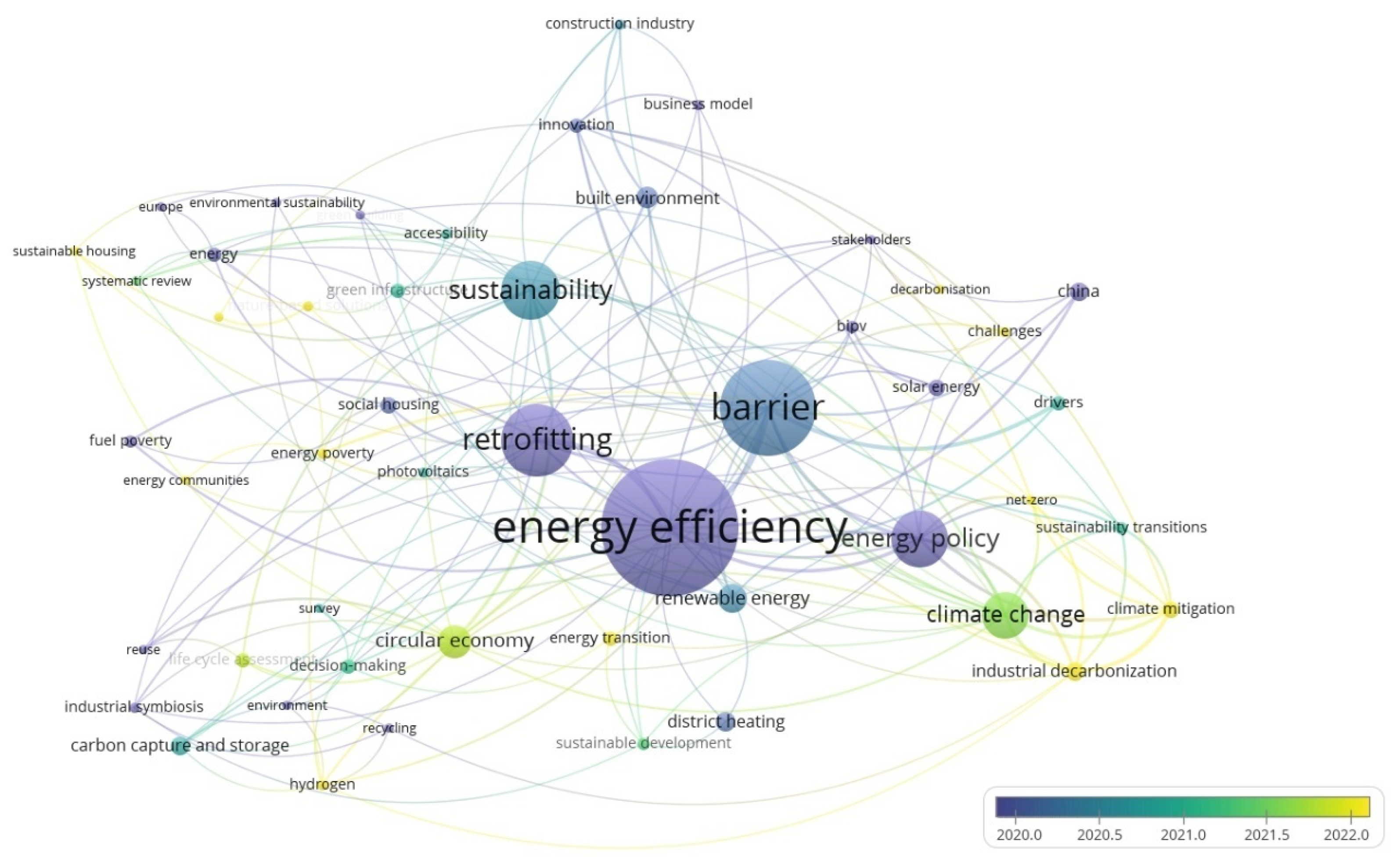
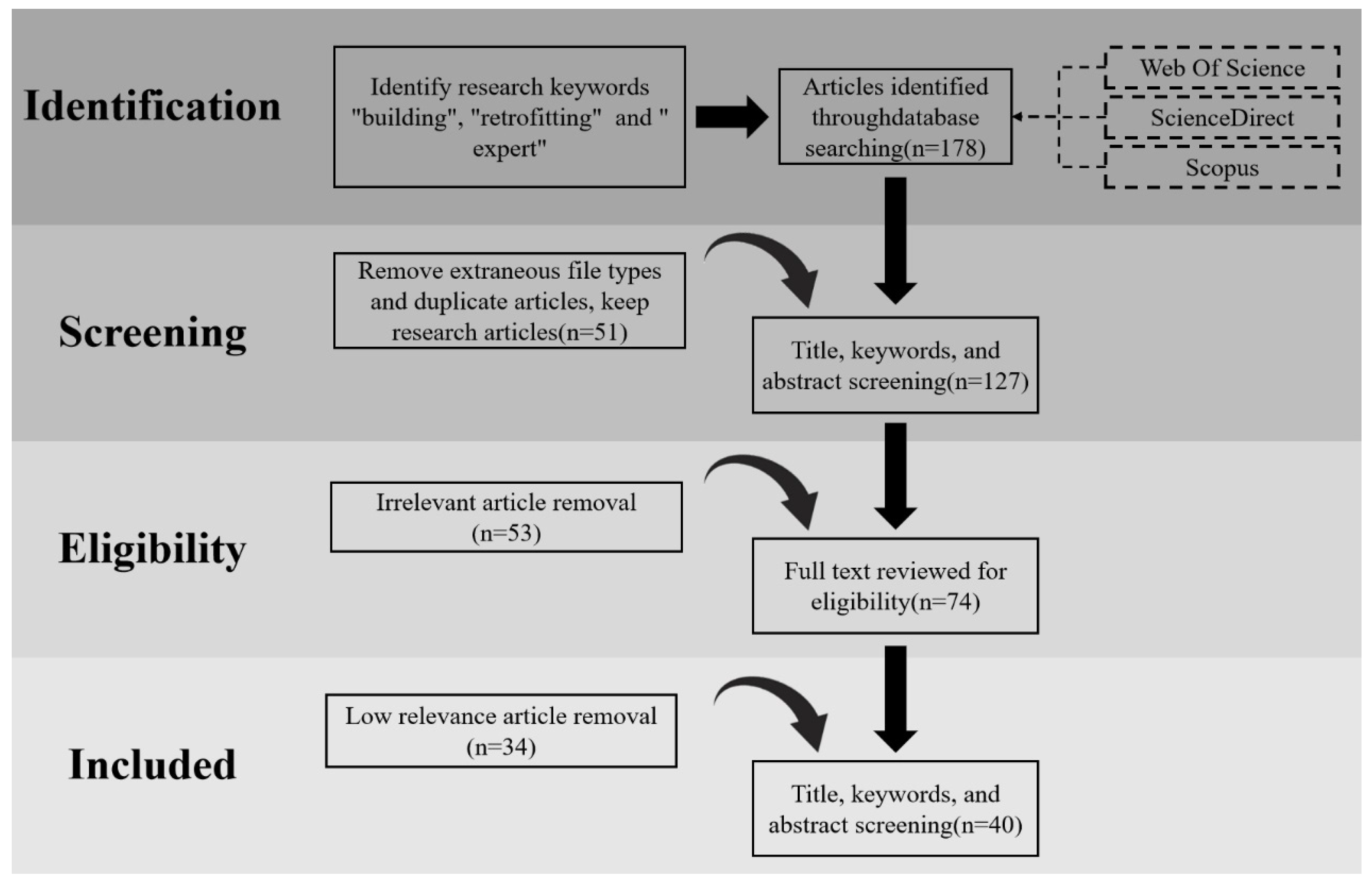
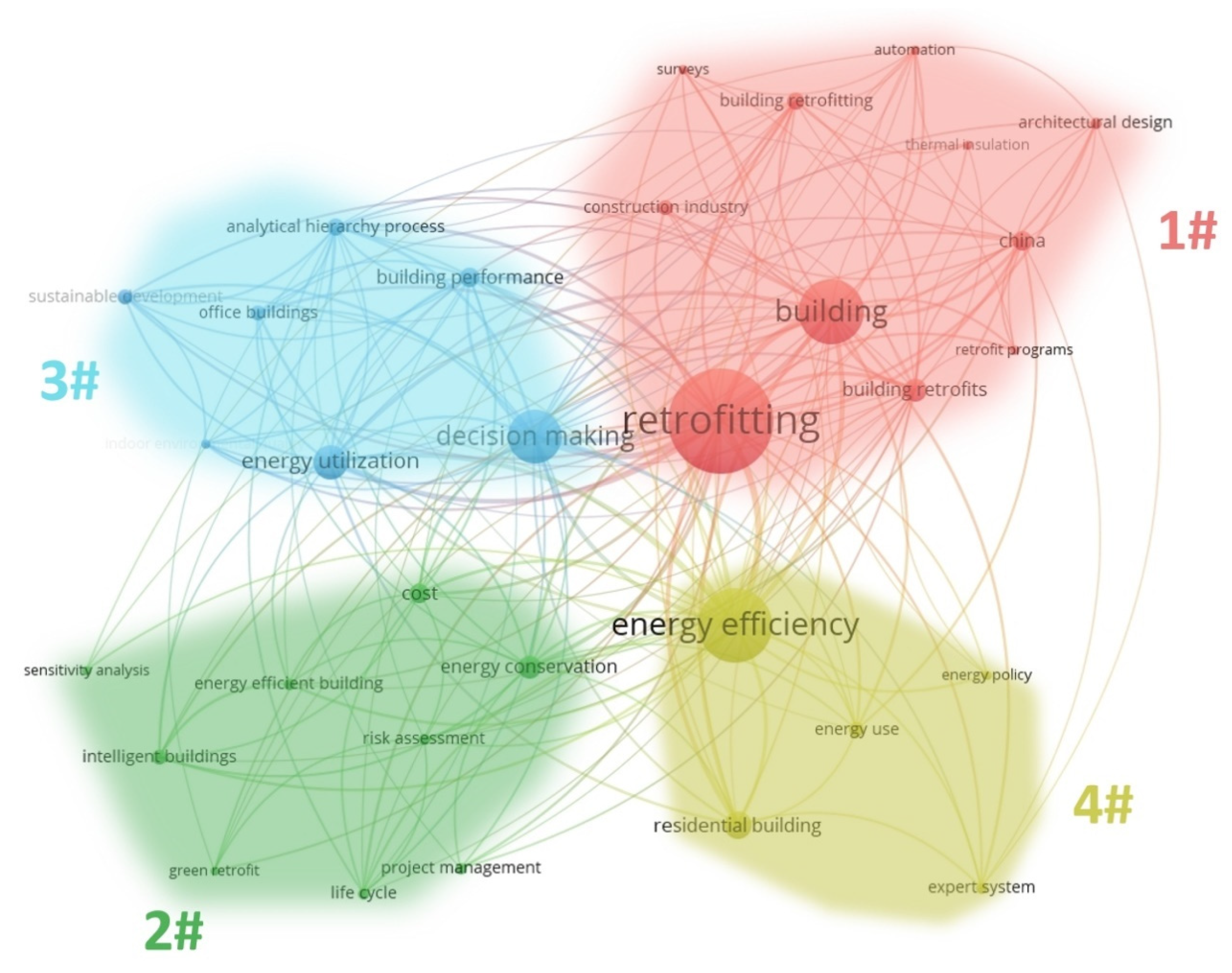


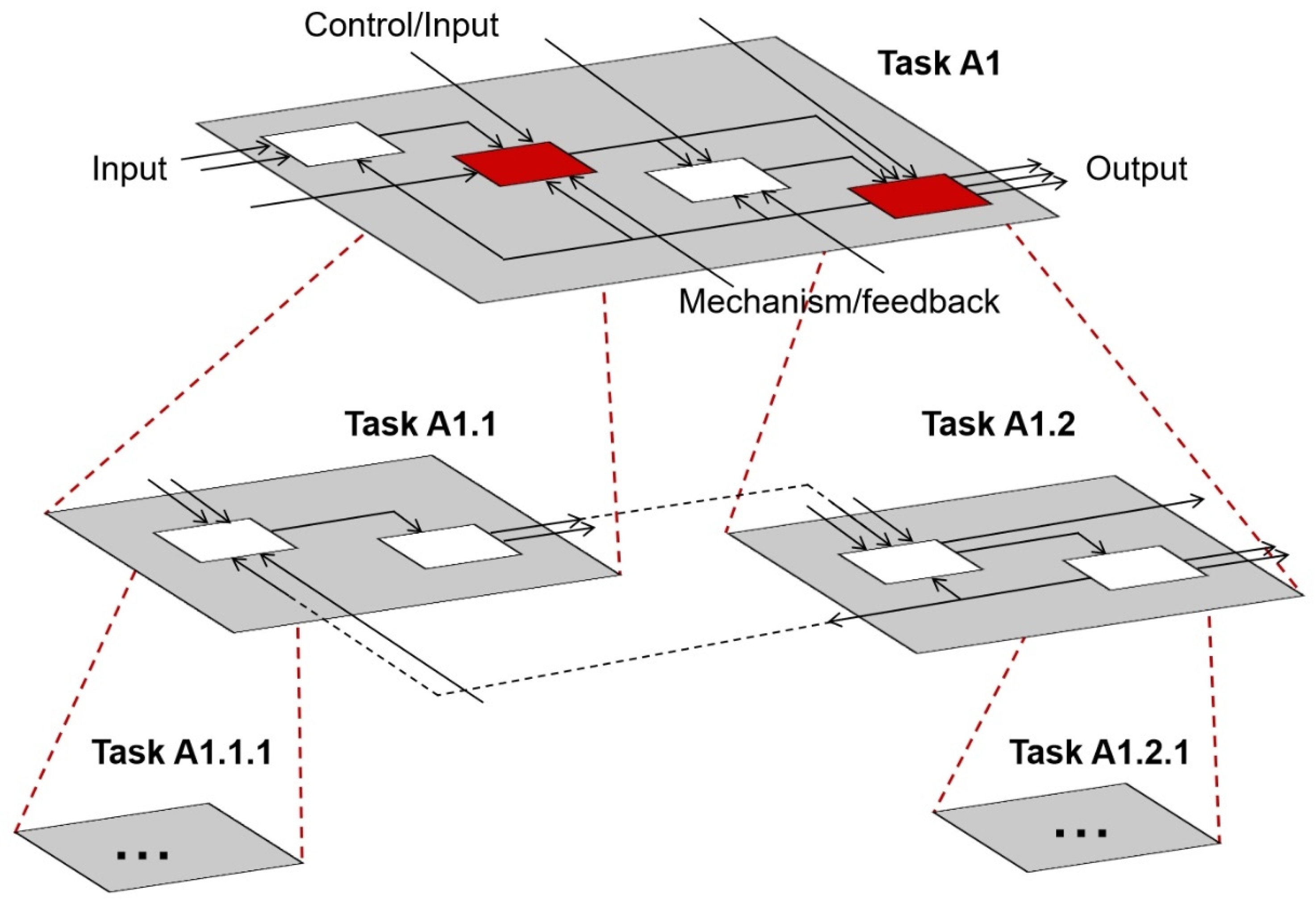
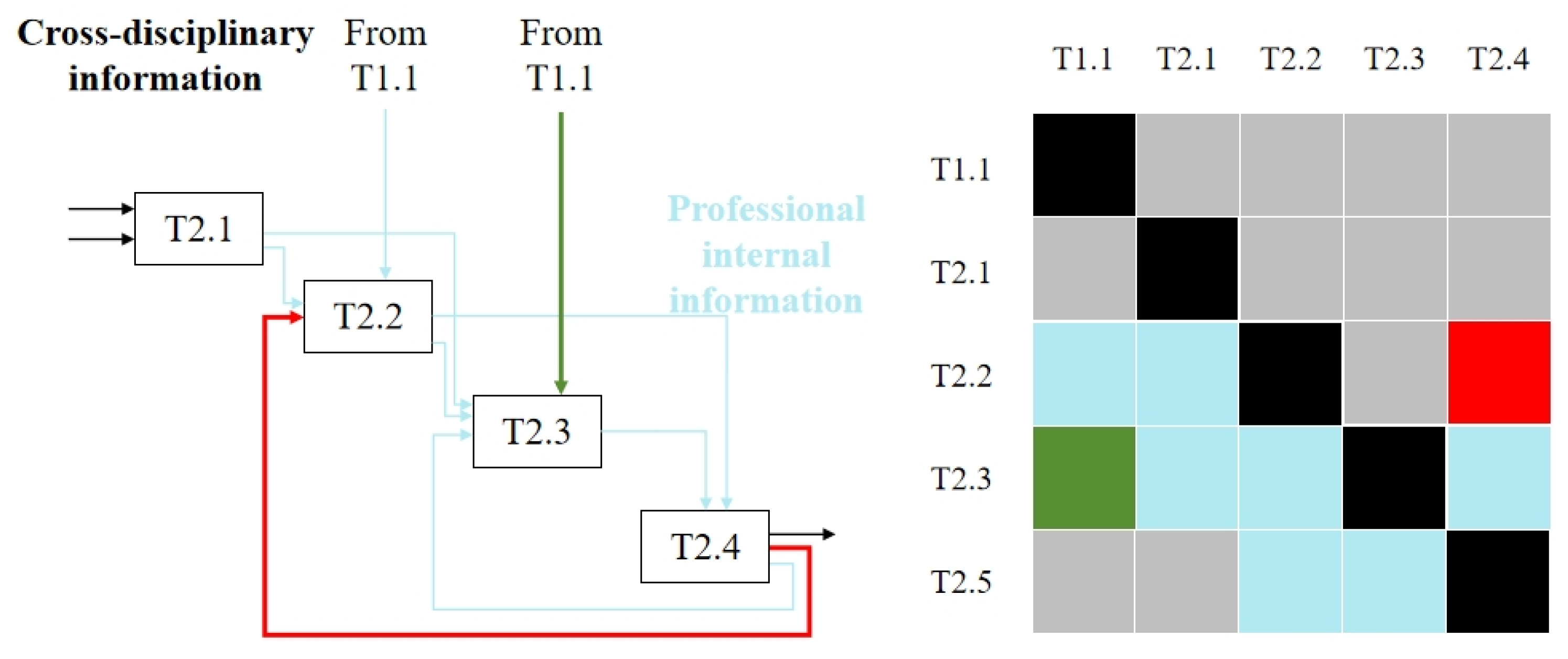
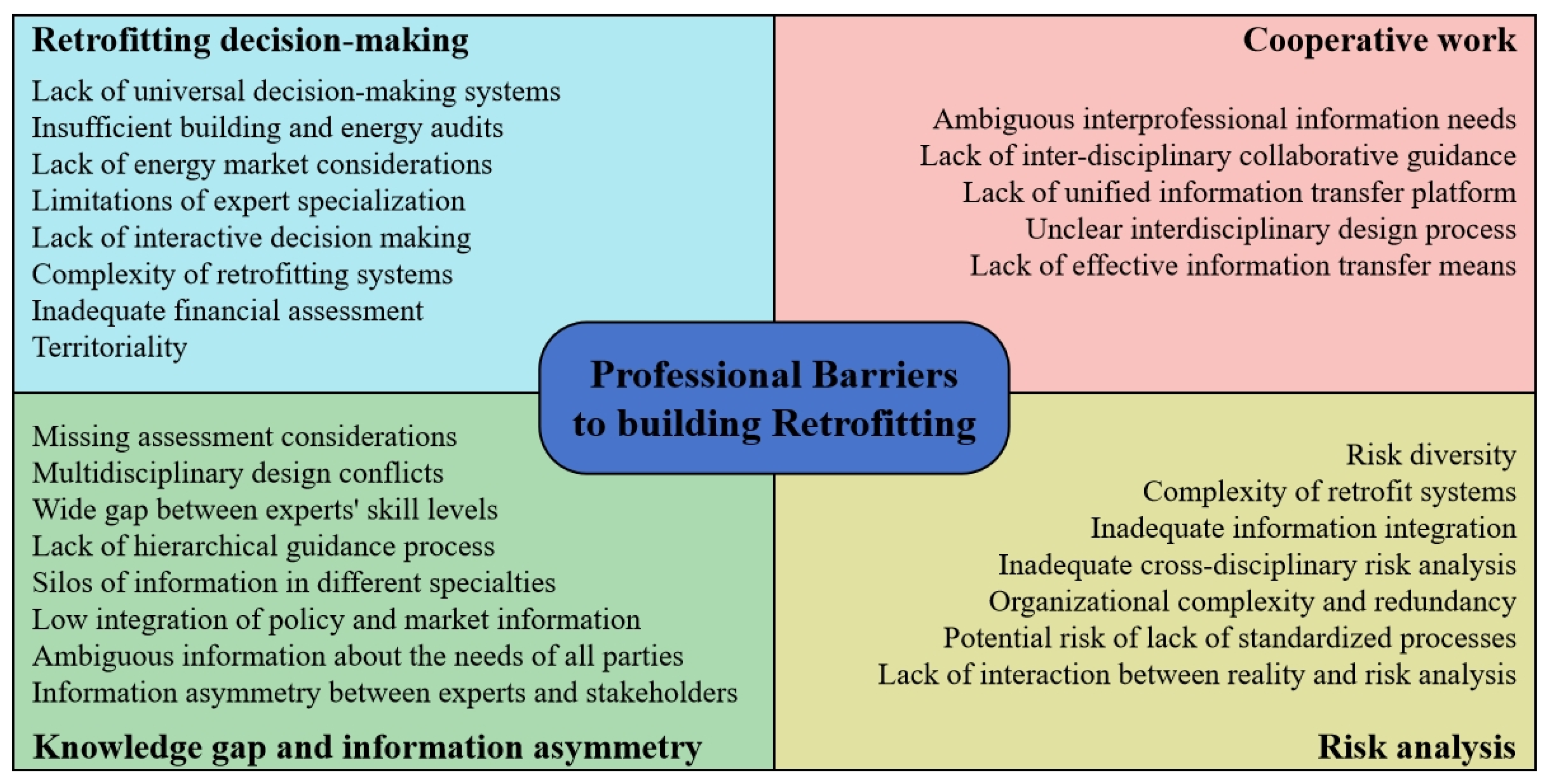

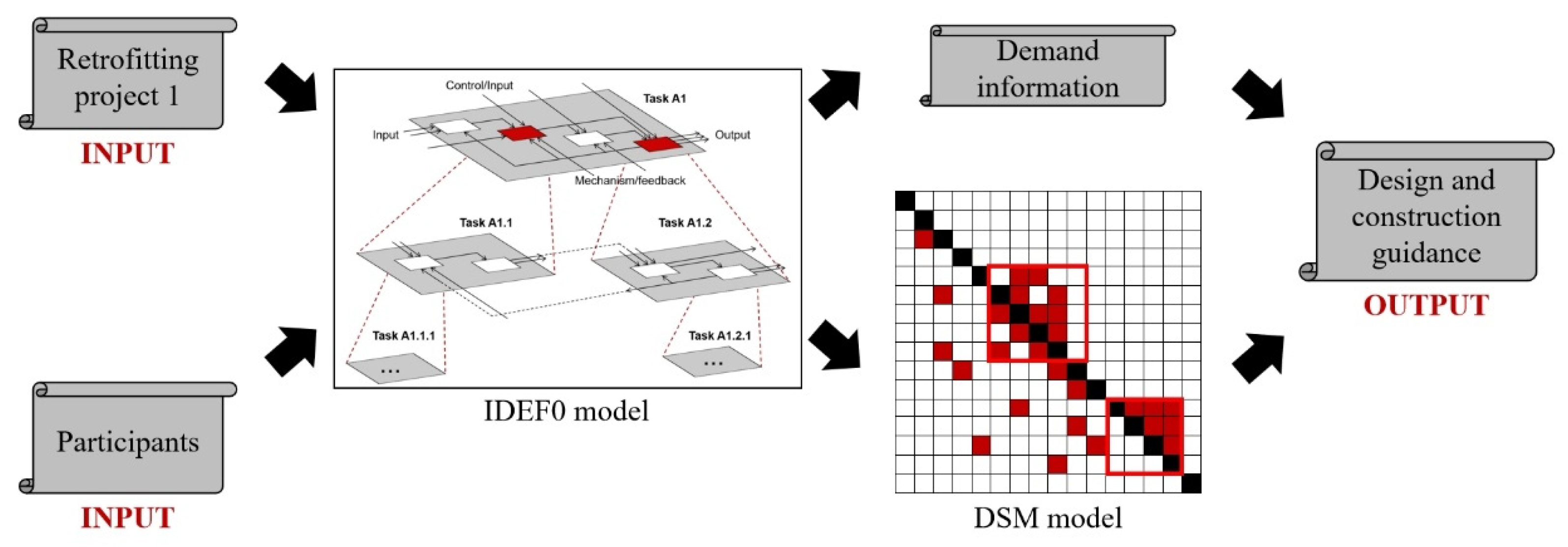
| Types of Barriers | Main Barriers | Research References to Barriers | Bibliography |
|---|---|---|---|
| Technical Barriers | The implementation of energy efficiency retrofits involves technologies of great professional complexity and there are large gaps in professional competence between different professionals (energy efficiency retrofits are too complex) | Lack of technical knowledge and expertise is a significant barrier, leading to poor remodeling results. | [26] |
| A lack of technical awareness among professionals can significantly reduce the outcome of a final remodel. | [27] | ||
| Lack of knowledge about building retrofitting and the constraints of the current state of the art. | [28] | ||
| Lack of knowledge leads to a limited understanding of the available technologies in energy efficiency retrofits and limited knowledge of building conditions to efficiently select implementation options (inadequate building audits) | Lack of complete information can be a huge deterrent to choosing to invest in energy-efficient technologies. | [29] | |
| Asymmetric information among the involved parties and a lack of common goals lead to information gaps during the course of the project. | [30] | ||
| Limited knowledge of the aging properties of building materials. | [31] | ||
| Lack of proper understanding of the performance of older buildings. | [32] | ||
| Lack of adequate documentation of proven sustainable retrofitting techniques for old buildings. | [33] | ||
| Unclear information about the needs of the building of energy efficiency retrofits process and not knowing which organizations need to share information (unclear information needs) | Lack of important meter data can have a huge impact on energy efficiency estimates. | [34] | |
| Lack of knowledge of current energy efficiency processes and what data are needed for the audits. | [35] | ||
| Insufficient knowledge of material parameters in the same building series can lead to large errors in assessments. | [36] | ||
| Limited knowledge of the sources and properties of sustainable materials for building retrofits. | [37] | ||
| Economic Barriers | Lack of detailed and accurate energy use data and forecasts of retrofit effects, while the flow of multidisciplinary information in actual retrofits is restricted, and energy audits and payback calculations are not accurately assessed (poor integration of cost–benefit-related information leads to uncertainty in energy audits and payback periods) | Lack of information is a significant barrier to energy efficiency estimations in energy efficiency retrofits, and incorrect energy efficiency estimates can lead to errors in the final evaluation of the program. | [38] |
| The methodology for calculating the payback time for energy efficiency measures is based on self-defined formulae, and some retrofitters do not really know yet how to calculate the payback time for energy efficiency measures. | [30] | ||
| Investors are not clear about the payment calculation method, the actual retrofit effect, and the potential benefits that largely affect the motivation of energy efficiency retrofits. | [39] | ||
| Lack of energy audits can address information and uncertainty issues that concern a variety of cross-disciplinary information, with the explicit mentioning of the lack of information as one of the more significant barriers. | [29] | ||
| Information barriers are one of the major issues in energy efficiency retrofits, including cognitive, managerial, and technical aspects, further increasing the economic uncertainty. | [26] | ||
| Some energy audits give less consideration to the cost. | [40] | ||
| Life cycle costing remains a challenging task, and the lack of interdisciplinary cooperation has resulted in the lack of a coordinated approach to the task. | [41] | ||
| The security of the payback period of energy efficiency retrofit projects is limited by the inaccurate assessment of the calculation of the project’s cost–benefit. | [42] | ||
| Lack of information sharing and advice, limited resources and knowledge, and the risk of not realizing expected energy efficiencies. | [43] | ||
| Often, when the initial investment is too large, there is no option to change to a less costly program, but rather to try to convince the investor (the initial investment is too large) | The problem of the excessive initial investment can be effectively dealt with through programmatic changes, of which the identification of programmatic and financing instruments prior to the start of a project is a major obstacle. | [26] | |
| The initial availability of funds is the most decisive factor for district-scale renovation and directly determines most of the renovation approaches. | [44] | ||
| High up-front costs, insufficient and unstable funding, and insufficient financial instruments available to support the reasonable costs of the benefits are major problems for the economy. | [31] | ||
| Related to local government finances, fiscal incentives, tax grounds, grants, and direct subsidies from different regional governments lack real-world considerations (the lack of government incentives) | Government financial subsidies can promote institutional and individual incentives for retrofitting, while there is a lack of credible information on energy efficiency. | [27] | |
| In China, a complex and effective financing policy has not yet been developed. Without financial incentives, residents, heating companies, and ESCOs have no incentive to move forward. Long-term incentive mechanisms or subsidy policies should be implemented immediately. | [45] | ||
| Economic interventions (subsidies) can work to some extent. | [40] | ||
| Environmental Barriers | Lack of a standardized quantitative framework for carbon emissions from building renovations and subsequent operations (the lack of a standardized carbon accounting framework) | Limited interdisciplinary knowledge transfer in building retrofitting has been identified as a major barrier. A key issue among these challenges is the lack of standardized assessment tools for environmental aspects. | [41] |
| Accounting for gaps in building performance, invisible carbon emissions and carbon offsets in the carbon framework are major barriers. | [46] | ||
| Evaluating the environmental impact from the perspective of a software engineer, design-oriented and interdisciplinary connections, data transparency, and incentives were identified as the most important aspects. | [47] | ||
| Other Barriers | Complex interest disputes between stakeholders | Information asymmetry among stakeholders makes the willingness to transform inconsistent and even backward-looking among parties. | [48] |
| Information asymmetry between the public and experts/government | When energy efficiency retrofits are undertaken, the participants’ awareness of energy efficiency and knowledge of the benefits can contribute greatly to energy efficiency retrofits. | [29] |
| Stages Involved | Content | Year | Bibliography | |||||
|---|---|---|---|---|---|---|---|---|
| Design | Construction | Full Process | Retrofitting Decisions | Cooperative Work | Process Design | Risk Analysis | ||
| × | × | 2025 | [50] | |||||
| × | × | 2024 | [51] | |||||
| × | × | 2024 | [52] | |||||
| × | × | 2024 | [53] | |||||
| × | × | 2023 | [54] | |||||
| × | × | 2023 | [55] | |||||
| × | × | 2023 | [56] | |||||
| × | 2023 | [57] | ||||||
| × | × | 2023 | [58] | |||||
| × | × | 2022 | [59] | |||||
| × | 2021 | [60] | ||||||
| × | × | 2021 | [61] | |||||
| × | × | 2021 | [62] | |||||
| × | × | 2021 | [63] | |||||
| × | × | 2021 | [64] | |||||
| × | 2021 | [65] | ||||||
| × | × | 2021 | [66] | |||||
| × | × | 2020 | [67] | |||||
| × | × | 2020 | [68] | |||||
| × | × | 2020 | [69] | |||||
| × | × | 2019 | [70] | |||||
| × | × | 2019 | [71] | |||||
| × | 2019 | [72] | ||||||
| × | × | 2019 | [73] | |||||
| × | × | 2018 | [74] | |||||
| × | × | 2018 | [75] | |||||
| × | × | 2017 | [76] | |||||
| × | × | 2017 | [77] | |||||
| × | × | 2017 | [78] | |||||
| × | × | 2017 | [79] | |||||
| × | × | 2017 | [80] | |||||
| × | × | 2016 | [81] | |||||
| × | × | 2016 | [82] | |||||
| × | × | × | 2015 | [83] | ||||
| × | × | 2015 | [84] | |||||
| × | × | 2015 | [85] | |||||
| × | × | 2015 | [86] | |||||
| × | × | × | 2014 | [87] | ||||
| × | × | 2014 | [88] | |||||
| × | 2014 | [89] | ||||||
| 32 | 3 | 5 | 26 | 5 | 2 | 4 | Number of relevant studies | |
| Research Location | Total Number of Risks | Number of Risks of Inappropriate Coordination | Percentage Share of Total Number | Weighting | Bibliography |
|---|---|---|---|---|---|
| China—Hong Kong | 18 | 10 | 55.6% | / | [96] |
| China | 21 | 9 | 42.8% | / | [97] |
| China—Southern Region | 8 | 5 | 62.5% | / | [98] |
| Russia | 22 | 10 | 45.4% | 36.3% | [99] |
| China | 11 | 6 | 54.5% | 53.6% | [100] |
| Modeling Technology Name | Disadvantages of Information Modeling | Bibliography |
|---|---|---|
| Program Evaluation and Review Technique (PERT) | Insufficient flexibility and over-reliance on predetermined activity grids and duration estimates make it difficult to track task follow-up. Inability to provide a detailed account of the information flow, only predicting the elapsed time of events, and not taking into account the impact of the uncertainties involved. Probabilistic, using probabilistic estimates to measure the project elapsed time. | [108] |
| IDEF Modeling Methodology | The system is highly complex, with a huge upfront investment, requiring knowledge of the entire event process, for the input, output, mechanism, and control information requires the full cooperation of personnel from multiple departments. Highly integrated information, high requirements for personnel, requiring the participation of personnel with a high level of specialized knowledge. Expandability: for new technology, new processes can be based on the original model to establish a new IDEF0 model. Substitutable modularity: the IDEF0 model consists of modules, and any module can be replaced by a new module under the condition of ensuring correct information flow. Modeling normalization: the symbols and rules used in the IDEF0 modeling are unified and recognized by various industries. Process normalization: the IDEF0 modeling establishes processes with sequential logic that can be used to guide the design or implementation of processes. Hierarchical: the IDEF0 modeling is based on task decomposition (WBS), with multiple levels of task hierarchy. | [109,110] |
| Petri Net | The system has a large amount of computation and is prone to data explosion; when the nodes and tokens are increased, the data on the original basis increase exponentially, leading to difficulty in verification. Flexibility: the logic of complex or dynamic behavior of the system can be processed by adding or subtracting nodes, and has a strong processing capacity. Lack of time dimension: the ability to express event time dimension information is weak. | [111,112] |
| Data Flow Diagram (DFD) | Inadequate representation of information dependencies and inability to characterize the complex dependencies and interactions between parts of the information. Intuitive: graphical representation and easy to understand. Statelessness: DFD does not focus on the state changes in the system, only on the processing and flow of data. Different perspectives and understanding of processes by each person make it difficult to standardize the same system, and require the intervention of people who are more familiar with the processes. | [113,114,115] |
| Design Structure Matrix (DSM) | Ease of operation through the matrix form to represent the structure and dependence of the system; easy to analyze and optimize. Collaborative decoupling, which can be based on matrix iteration, and with a strong collaborative decoupling effect for negative feedback information. Versatility: can be used for system design and also for project management and schedule control. | [116,117] |
| System Dynamics Model | Quantifiable: capable of quantitative analysis and numerical simulation to assess the performance of the system. Fuzzy transfer of information, with only positive and negative feedback, as well as cause and effect relationships. | [118,119] |
Disclaimer/Publisher’s Note: The statements, opinions and data contained in all publications are solely those of the individual author(s) and contributor(s) and not of MDPI and/or the editor(s). MDPI and/or the editor(s) disclaim responsibility for any injury to people or property resulting from any ideas, methods, instructions or products referred to in the content. |
© 2025 by the authors. Licensee MDPI, Basel, Switzerland. This article is an open access article distributed under the terms and conditions of the Creative Commons Attribution (CC BY) license (https://creativecommons.org/licenses/by/4.0/).
Share and Cite
Liao, X.; Wang, C.; Li, B.; Li, B.; Du, C. Professional Barriers in Energy Efficiency Retrofits—A Solution Based on Information Flow Modeling. Buildings 2025, 15, 280. https://doi.org/10.3390/buildings15020280
Liao X, Wang C, Li B, Li B, Du C. Professional Barriers in Energy Efficiency Retrofits—A Solution Based on Information Flow Modeling. Buildings. 2025; 15(2):280. https://doi.org/10.3390/buildings15020280
Chicago/Turabian StyleLiao, Xilong, Chun Wang, Baiyi Li, Baizhan Li, and Chenqiu Du. 2025. "Professional Barriers in Energy Efficiency Retrofits—A Solution Based on Information Flow Modeling" Buildings 15, no. 2: 280. https://doi.org/10.3390/buildings15020280
APA StyleLiao, X., Wang, C., Li, B., Li, B., & Du, C. (2025). Professional Barriers in Energy Efficiency Retrofits—A Solution Based on Information Flow Modeling. Buildings, 15(2), 280. https://doi.org/10.3390/buildings15020280







